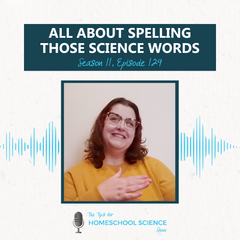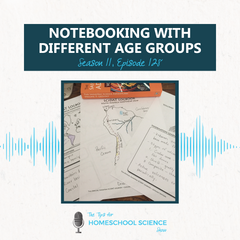FREE Shipping on all our products! (Please Note: Orders may experience a delay of a week or more in shipping due to the high volume of orders at this time of year.)
FREE Shipping on all our products! (Please Note: Orders may experience a delay of a week or more in shipping due to the high volume of orders at this time of year.)
Q2: What should a week with science look like? {Season 5, Episode 75}
September 09, 2019 4 min read

Welcome to season 5 of the Tips for Homeschool Science Show where we are breaking down the lofty ideals of teaching science into building blocks you can use in your homeschool.
In our last episode, we chatted about why we need to teach science. Today, we are going to take a closer look at what your week should look like.
Listen to this episode
You can find this podcast on iTunes, Google Play, Stitcher, or Spotify or you can listen and watch the episode right here.
Share the Tips
If you found these homeschool science tips to be helpful, would you please take a moment to rate it on iTunes or Google Play? This would help me tremendously in getting the word out so that more earbuds are filled with science-teaching encouragement.
Q2 Transcripts

What should your week with science look like?
In our last episode, we covered the importance of teaching science in your home. Today, we are going to flesh out what this actually looks like.
There are three main keys you need to hit for science each week. You need to do science. You need to gather scientific information. And you need to tell others what you learned about science.
Let’s take a closer look at these core items.
Do
First, you need to do some kind of hands-on science. You need to guide your students to see science face-to-face. To see science in action so that they get excited about learning more and don’t get bogged down in fact after fact after fact.
The initial thought for hands-on science is towards demonstrations or experiments, but you can use nature study, field trips, and more to help your students play with and observe the principles of science at work.
In the beginning, doing science will be more like playing with science. As your student's age, they will turn into detectives – testing the principles of science through experiments.
If you approach hands-on science in this way, doing becomes something fun we get to do instead of something we have to check off.
Gather
Second, you need to gather information. Science is both a context and a content subject, which is a fancy way of saying that we can see science in action, but we also need to study the principles and facts of science we know to be true.
Thankfully, as homeschoolers, we have access to so many resources beyond the standard textbook. Although we believe that textbooks do have value for sharing science, we know that for the younger years there are lots of options to share science.
We can use resources like adventure-filled living books, visually appealing children’s encyclopedias, and simple non-fiction books. And in this digital age, we can also use podcasts and videos to share science with our kiddos. The point is to find a resource that your students enjoy learning from, one that doesn’t cause their eyes to glaze over.
If you approach scientific facts in this way, gathering becomes something that our students dive into fully instead of something we have to force them into.
Tell
Third, you need to have your students tell you what they have learned. You want to discuss what you did and what you gathered with your students.
Ideally, you will chat about what you learned and then have the students write all or part of what you discussed in the form of a narration. You can write this down for them in the earlier years and start turning over this task as they mature in their writing abilities. Just make sure that you don’t push the students to write beyond their abilities – you want the telling they do in science to be easy for them.
If you approach writing in this way, telling becomes something that our students will treasure and look back at for years to come instead of a chore they have to do.
Wrapping it Up

Do.
Gather.
Tell.
It’s that simple.
Of course, there are tons of Pinterest projects and other resources you can add in to enhance the core of your plans, but as long as you are doing, gathering, and telling each week – you are hitting all the high points of what you need for science.
You can use a plan that lays these three keys for you or fold learning into your life. Either way, you need to do, gather, and tell each week for science. How those three items are fleshed out in your homeschool will be as unique as you are.
I trust that by now you can see what a week of science should look like. Here are a few helpful episodes about doing, gathering, and telling:
Next week, we are going to chat about whether or not you should combine your crew together for science. Until then, I hope you have a great week playing with science!
Also in {Podcast} The Tips for Homeschool Science Show
All About Spelling Those Science Words {Season 11, Episode 129}
March 25, 2024 7 min read

In this episode, we'll be interviewing Robin Williams from All About Spelling. Click "Read More" to listen is as we discuss tips and tricks for spelling all those science words!
How should you handle notebooking through the different ages? {Season 11, Episode 128}
March 18, 2024 3 min read

Writing in Science with a Well-Trained Mind (Interview) {Season 11, Episode 127}
March 11, 2024 16 min read

Click "Read More" to listen in as Susan Wise Bauer and Susanna Jarret join Paige to share tips and tools about the third key to teaching science!
Subscribe
Sign up to get the latest on sales, new releases and more …

